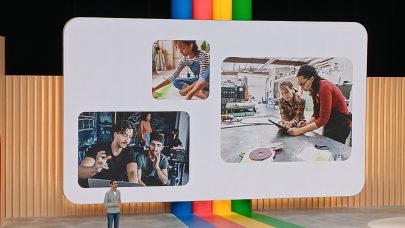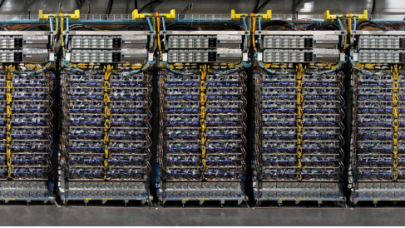
Top 5 Trends in HPC for the First Six Months of 2023
July 12, 2023
Editor’s note; In light of recent updates to Google’s Privacy Policy, “For example, we use publicly available information to help train Google’s AI mo Read more…

Google’s New AI-Focused ‘A3’ Supercomputer Has 26,000 GPUs
May 10, 2023
Cloud providers are building armies of GPUs to provide more AI firepower. Google is joining the gang with a new supercomputer that has almost 2.5 times the number of GPUs than the world’s third-fastest supercomputer called LUMI. Google announced an AI supercomputer with 26,000 GPUs at its developer conference on Wednesday. Read more…

Google AI Supercomputer Shows the Potential of Optical Interconnects
April 10, 2023
There are limits on the speed of how fast copper wires can move data between computers, and a transition to light speed will ultimately drive AI and high-performance computing forward. Every major chipmaker is in agreement that optical interconnects will be needed to reach zettascale computing in an energy-efficient way. That opinion was... Read more…

Google Claims Its TPU v4 Outperforms Nvidia A100
April 6, 2023
A new scientific paper from Google details the performance of its Cloud TPU v4 supercomputing platform, claiming it provides exascale performance for machine le Read more…

Google Sheds Quantum Supremacy Notoriety to Focus on Stability
February 27, 2023
Google over the last few years has thrown shade at today's fastest supercomputers with dubious claims of achieving "quantum supremacy." The tech giant may be ba Read more…

Google and Microsoft Set up AI Hardware Battle with Next-Generation Search
February 20, 2023
Microsoft and Google are driving a major computing shift by bringing AI to people via search engines, and one measure of success may come down to the hardware a Read more…

US DOD Ends Cloud Drama with $9 Billion Contract to Top Cloud Providers
December 8, 2022
The U.S. Department of Defense wielded its JEDI powers to procure public cloud services with a diplomatic end to a feud between Amazon and Google to win the multi-billion dollar contract. The DoD broke up a $9 billion contract between the top four cloud providers – Google, Amazon, Microsoft and Oracle – for the Joint Warfighting Cloud Capability initiative, which will bring the defense branches – Air Force, Army... Read more…

CEO Jack Hidary on SandboxAQ’s Ambitions and Near-term Milestones
October 18, 2022
Spun out from Google last March, SandboxAQ is a fascinating, well-funded start-up targeting the intersection of AI and quantum technology. “As the world enter Read more…

- Click Here for More Headlines

Whitepaper
Transforming Industrial and Automotive Manufacturing
In this era, expansion in digital infrastructure capacity is inevitable. Parallel to this, climate change consciousness is also rising, making sustainability a mandatory part of the organization’s functioning. As computing workloads such as AI and HPC continue to surge, so does the energy consumption, posing environmental woes. IT departments within organizations have a crucial role in combating this challenge. They can significantly drive sustainable practices by influencing newer technologies and process adoption that aid in mitigating the effects of climate change.
While buying more sustainable IT solutions is an option, partnering with IT solutions providers, such and Lenovo and Intel, who are committed to sustainability and aiding customers in executing sustainability strategies is likely to be more impactful.
Learn how Lenovo and Intel, through their partnership, are strongly positioned to address this need with their innovations driving energy efficiency and environmental stewardship.
Download Now
Sponsored by Lenovo
Whitepaper
How Direct Liquid Cooling Improves Data Center Energy Efficiency
Data centers are experiencing increasing power consumption, space constraints and cooling demands due to the unprecedented computing power required by today’s chips and servers. HVAC cooling systems consume approximately 40% of a data center’s electricity. These systems traditionally use air conditioning, air handling and fans to cool the data center facility and IT equipment, ultimately resulting in high energy consumption and high carbon emissions. Data centers are moving to direct liquid cooled (DLC) systems to improve cooling efficiency thus lowering their PUE, operating expenses (OPEX) and carbon footprint.
This paper describes how CoolIT Systems (CoolIT) meets the need for improved energy efficiency in data centers and includes case studies that show how CoolIT’s DLC solutions improve energy efficiency, increase rack density, lower OPEX, and enable sustainability programs. CoolIT is the global market and innovation leader in scalable DLC solutions for the world’s most demanding computing environments. CoolIT’s end-to-end solutions meet the rising demand in cooling and the rising demand for energy efficiency.
Download Now
Sponsored by CoolIT
Advanced Scale Career Development & Workforce Enhancement Center
Featured Advanced Scale Jobs:
HPCwire Resource Library
HPCwire Product Showcase
© 2024 HPCwire. All Rights Reserved. A Tabor Communications Publication
HPCwire is a registered trademark of Tabor Communications, Inc. Use of this site is governed by our Terms of Use and Privacy Policy.
Reproduction in whole or in part in any form or medium without express written permission of Tabor Communications, Inc. is prohibited.
























